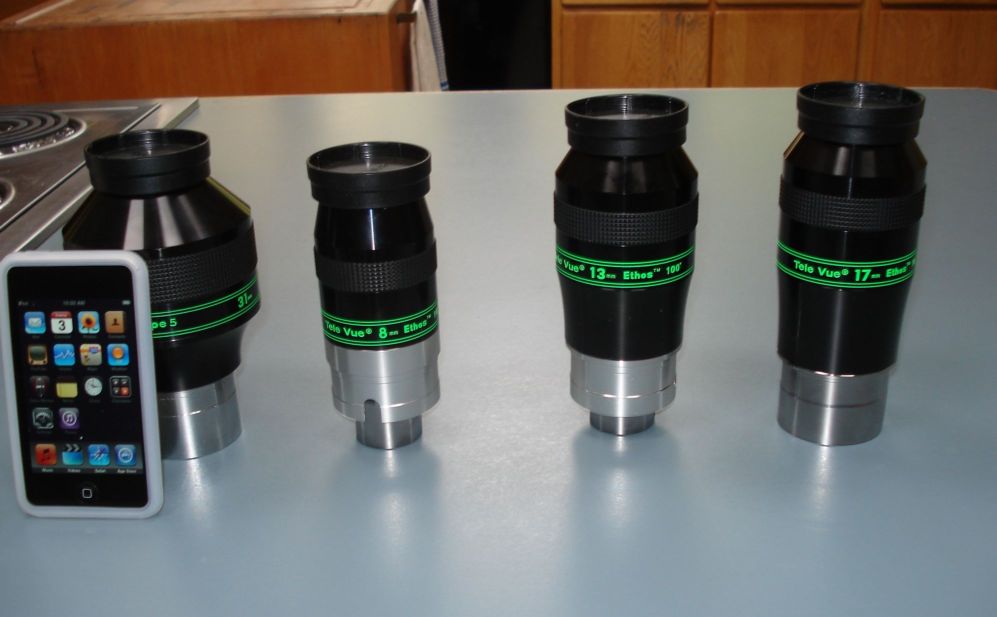
(Mostly the 13 mm)
By Ed Ting
Updated 10/20/10
TeleVue Ethos Eyepieces (10/11/10)
(Eyepieces of unspecified design with 100 degree FOV. 3.7 mm has 110 degree FOV)
21 mm ($850) 2" only
17 mm ($750) 2" only
13 mm ($620) 2" /1.25"
10 mm ($620) 2"/ 1.25"
8 mm ($585) 2"/ 1.25"
6 mm ($585) 2"/ 1.25"
3.7 mm ($620) 1.25" with 2" adapter
TeleVue stunned the world again in 2007 at NEAF with the introduction of the 100 degree FOV Ethos eyepieces. At the time, during daylight demonstrations with the 13 mm unit, there were some mixed reactions. Does the world need another expensive eyepiece? Al Nagler assured us that our opinions would change once we saw the eyepieces in action under dark skies. Sure enough, within the next year, Ethos eyepieces began popping up within our observing group. One observer in our club wound up selling his 13 mm Type 6 Nagler to help fund the purchase of the 13 mm Ethos. No one takes the purchase of a $600 eyepiece lightly, so Al must have been at least partially right. I'd been encouraged by casual views through the Ethos at star parties and became interested in checking it out more thoroughly. The 13 mm unit seems to be the one that most people start with (at least around here) so I'll confine my comments mostly to that model, although I'll talk a little bit about the 8 mm and 17 mm also.
The 13 mm Ethos sits in a popular focal length. There's a lot of competition out there, some of it from TeleVue itself. In the TeleVue line alone for example, there is already a 13 mm Type 6 Nagler, and 12 mm and 14 mm Radians. Discontinued, but still available used, are the original 13 mm Type 1 Nagler, the 12 mm Type 2 Nagler, and the old style 13 mm smooth-sided Plossl. I was anxious not only to test out the 13 mm Ethos, but to compare it to the other premium eyepieces within the TeleVue line. How good is it really, and is it worth the extra money over the (deservedly praised) 13 mm Type 6 Nagler?

31 mm Nagler Type 5 (L) pictured with the 8mm, 13 mm, and 17 mm Ethos eyepieces
The 13 mm Ethos is an imposing eyepiece. Its aspect ratio, like the other Ethos units, is long and thin, unlike the short and fat design we're used to seeing with the Naglers. If the Nagler is a "grenade" then the Ethos might be a "pipe bomb." It's so thin that some of us wondered how it's possible to squeeze a 100 degree FOV out of it. There must be some serious optical maneuvering going on inside. I'd love to know how it works, but at $600+ each, I'm not about to open it up to find out. Amazingly, 13 mm (and the shorter units) will fit inside 1.25" focusers. The 3.7 mm has an impressive 110 degree FOV and comes with a 2" adapter that doubles as a display stand, so you can impress your friends in the day time.
At 20.6 ounces, the 13 mm is heavy, but it's lighter than you might think if you own Naglers or Panoptics. All of the Ethos eyepieces have 15 mm of eye relief, which is just about ideal for most people unless you observe with very thick glasses. The 10 mm and 13 mm are parfocal with each other, but the others aren't (more on that later.) Be careful handling the bottom of the eyepiece, as there's a lens right down there near the edge. Interestingly, some observers found that the 13 mm is just narrow enough that some people are able to use them in binoviewers. In response to this, units shipped after March of 2008 have a slightly narrower (1.5 mm) barrel in an attempt to accommodate more observers. Although I haven't tried it, there are enough Ethos eyepieces and binoviewers in the club that I'm anxious to try it.
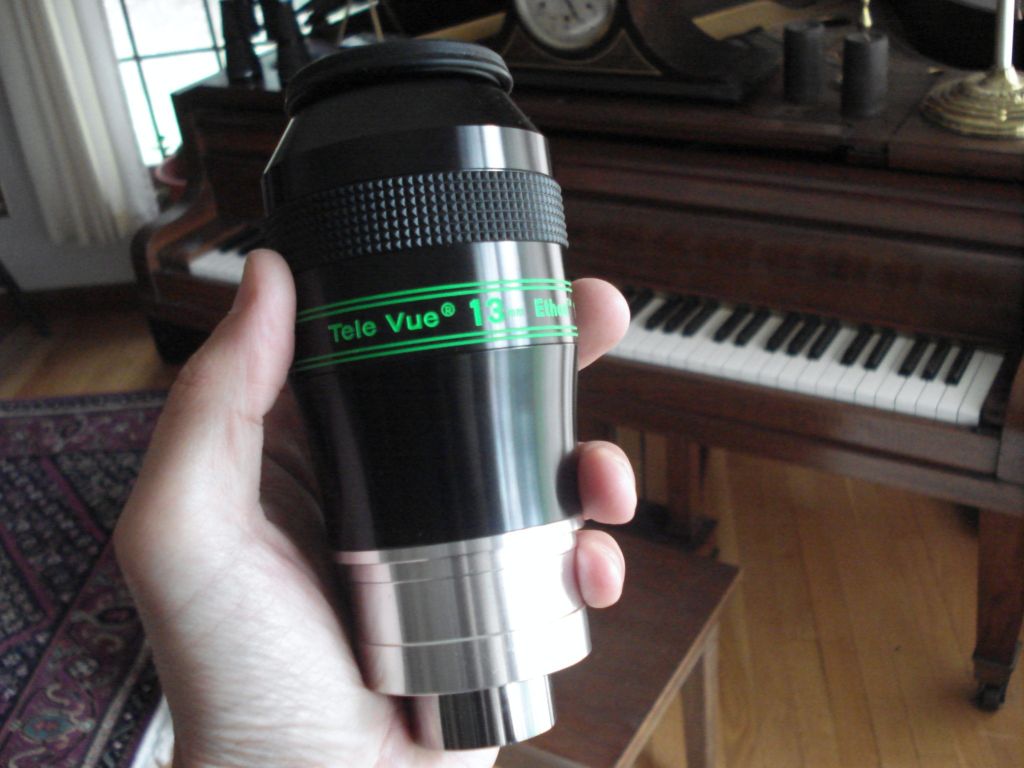
The 13 mm Ethos ($620)
On an unusually clear, cool and crisp October evening, I invited 6 of the more experienced club members over to do some testing and observing. Present in the field were the 20" Obsession, the 7" Starmaster Oak Classic, the 11" Starmaster EL, an Orion 8" f/5 Newtonian, and a Takahashi FSQ 106. We switched back and forth between the 13 mm Ethos, the 13 mm Nagler Type 6, and the original 13 mm Type 1 Nagler. Our targets were the usual fall fare - the Ring, Dumbbell, Veil, M13, M92, M15, M31, Albireo, the Blinking Planetary, the Blue Snowball, the Double Cluster, and the Cat's Eye. I found the rich star field around M56 to be useful in seeing how sharp the eyepieces were at the edges.
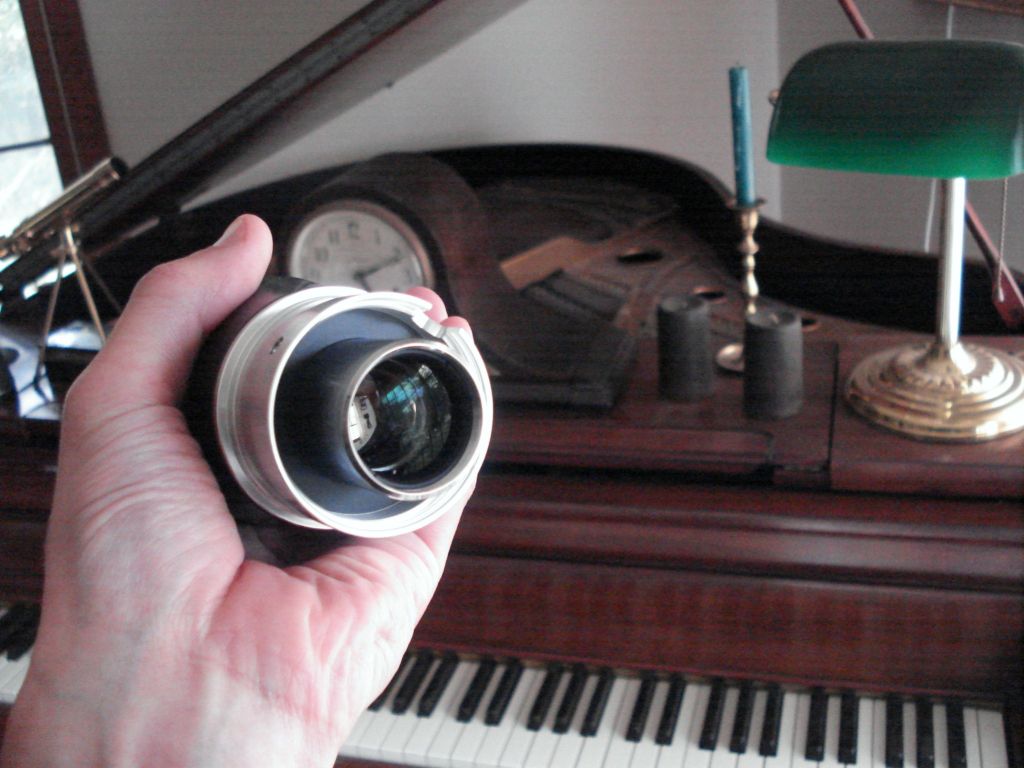
The 13 mm Ethos. Be careful handling the bottom of the eyepiece!
On paper, there shouldn't be much difference between the 13 mm Nagler Type 1, the 13 mm Nagler Type 6, and the Ethos. All will yield the same magnification, and the fields of view aren't that far apart. The Naglers are already giving you 82 degrees - is the 100 degree FOV going to be all that different? And on paper, there should be no difference at all between the two Naglers. On paper.
In comparing the three 13 mm eyepieces, two trends emerged right away:
Everyone was impressed by the Ethos.
Everyone noticed the kidney bean blackouts on the Type 1 Nagler.
If you're not aware of the latter phenomenon, the early Nagler eyepieces had kidney-shaped areas that would black out on you when you moved your head around. No one seemed to care much at the time; it was part of the price you paid for excellence of the rest of the eyepiece. But the Type 1 Naglers, though still very good, are a nearly 30 year old design now. Furthermore, once you learn to see the kidney beans, it's hard not to notice them. It's like the first time you learn to see chromatic aberration in a cheap refractor. You just can't go back.
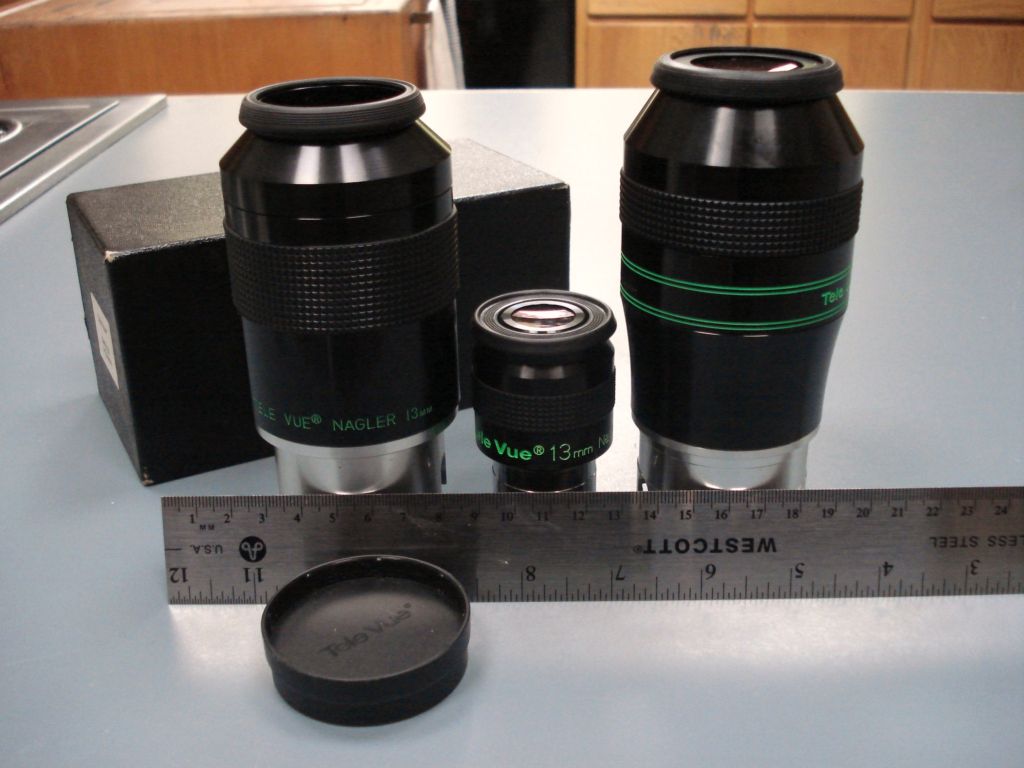
Three generations of premium TeleVue eyepieces -
The original 13 mm Type 1 Nagler (L), the new 13 mm Type 6 Nagler (M), and the 13 mm Ethos (R)
I'll list the comments from the other observers below, but here is my conclusion - the 13 mm Ethos is simply stunning. What's more, I am at a loss to explain why. By the numbers, it's just a wider field version of the Type 6 Nagler, but it just feels different. You get total immersion in the view. TeleVue points out that the 18 degree FOV difference doesn't sound like much, but in practice the Ethos will show you 50% more sky compared to a Nagler. To this end, TeleVue proposes a new measure called the Majesty Factor. You can check out the link yourself, but in short, the idea is this: The Ethos shows you so much sky, you can get away with a higher power eyepiece, get closer to the object, and have a darkened sky background, as compared to a conventional eyepiece like a Plossl or a Kellner.
In trying to explain why the Ethos looks so good, I started looking some statistics. One theory is the size of the eye lens. Another is the amount of eye relief. See below.
Eyepiece 13 mm T1 Nagler 13 mm T6 Nagler 13 mm Ethos
Eye Lens Diameter 27 mm 18 mm 29 mm
Eye Relief 18 mm 12 mm 15 mm
Field of View 82 degrees 82 degrees 100 degrees
Weight (lb/oz) 1.42/22.7 .4/6.4 1.3/20.8
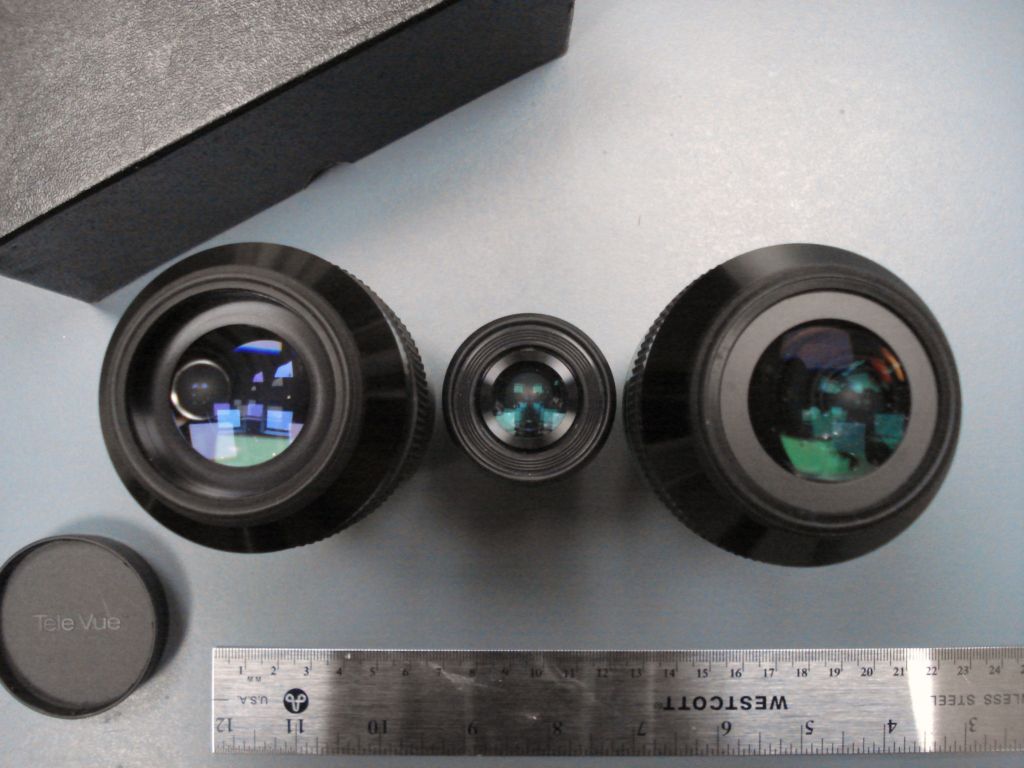
Eye lens size comparison - 13 mm NT1 (L), 13 mm NT6 (M), 13 mm Ethos (R)
In looking at the photo above, you get some idea of that big 'ol picture window effect the Ethos gives you. The eye lens is simply huge for a 13 mm eyepiece. Also, if you look carefully, you can see that the new eyepieces have better (darker) coatings. The Type 6's small eye lens and its relatively short 12 mm of eye relief made it feel a little claustrophobic compared to the other two. Not everyone agreed with this assessment (see below) as the Type 6 Nagler got plenty of praise. But I did feel more relaxed looking through the Ethos than through the others.
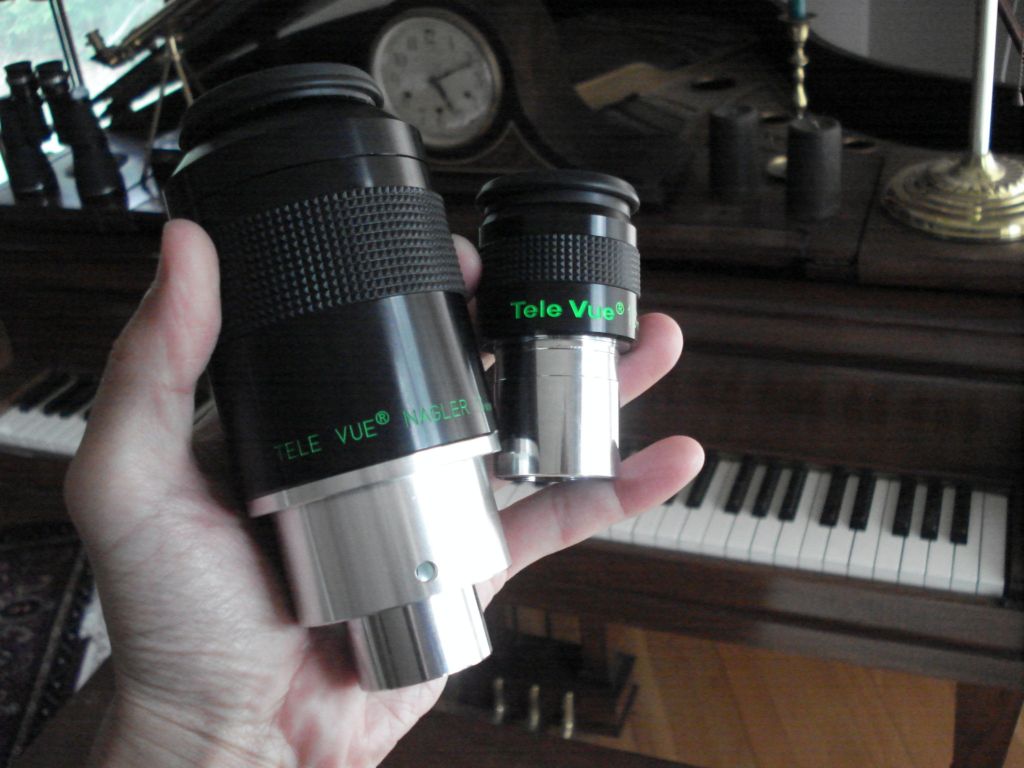
Two 13 mm Naglers. It's hard to believe these are functionally the same eyepiece.
Jupiter was up, and the Ethos performed just fine as a planetary eyepiece. A quick comparison with Plossls showed no difference in sharpness or contrast. The extra field around the planet was a nice bonus. In the Dobs, the additional FOV meant not having to move the scope as often. At a recent public skywatch, the full moon was up. Do yourself a favor - if you have a scope in the 1200 - 1600 mm focal length range, look at the full moon with the 13 m Ethos. It fills the eyepiece and looks as if it's shoved right in front of your face. You feel like an astronaut going in for a landing.
All of the premium eyepieces were sharp to the edge. One observer, Mike T, thought he saw some mild softness at the very edge of the Ethos, but later I discovered that my Oak Classic was out of collimation which probably explained this effect. I didn't notice any softness with the Ethos in any of the other scopes. Three of the observers thought the Type 6 Nagler had slightly more contrast and darker backgrounds than the Ethos, but admitted the effect was mild (curiously, TeleVue's web site suggests that the opposite will happen - the Ethos should have better contrast.) Looking over the comments below, I was surprised how well the Type 6 Nagler did. In fact, two of the observers picked the T6 Nagler as the winner.
For me though, it was the Ethos all the way. Like other premium TeleVue eyepieces, its appeal doesn't lie in the numbers. TeleVue just gets the intangibles right. I'm normally a hit-and-run type of observer, but the Ethos eyepieces forced me to slow down and just enjoy the view. In the Oak Classic, the Double Cluster is so nicely framed, I just sat and watched it for a while despite having seen it hundreds of times before. It was the same with the field around M56. After we all spent critical observing time comparing all three eyepieces in our scopes, we relaxed and started looking at whatever we wanted to see. The eyepieces scattered into various scopes. Time and time again, I kept calling out, "Who has the Ethos?"
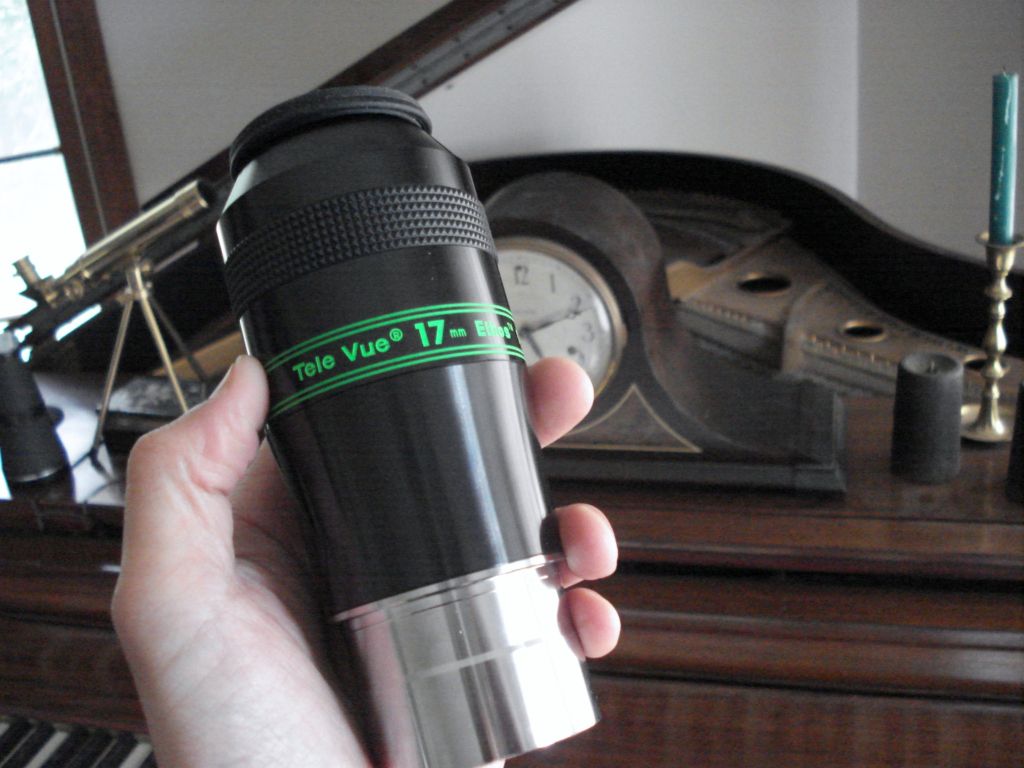
The impressive 17 mm Ethos ($750)
I spent some time with the 17 mm and 8 mm Ethos models as well. For the kind of observing that I do, the 17 mm is actually closer to what I need. I observe at slightly lower powers than most people and the 17 mm backs off on the magnification just enough for me. The 17 mm is not parfocal with the 13 mm. While the 13 mm requires you to out focus quite a bit (typical of many TeleVue eyepieces) the 17 mm makes you rack in. In fact, it would not come to focus on my Oak Classic, which has a low-profile focuser to begin with. This was frustrating, because I really wanted to look at the Double Cluster with it. I didn't notice any focus issues with any of the other scopes.
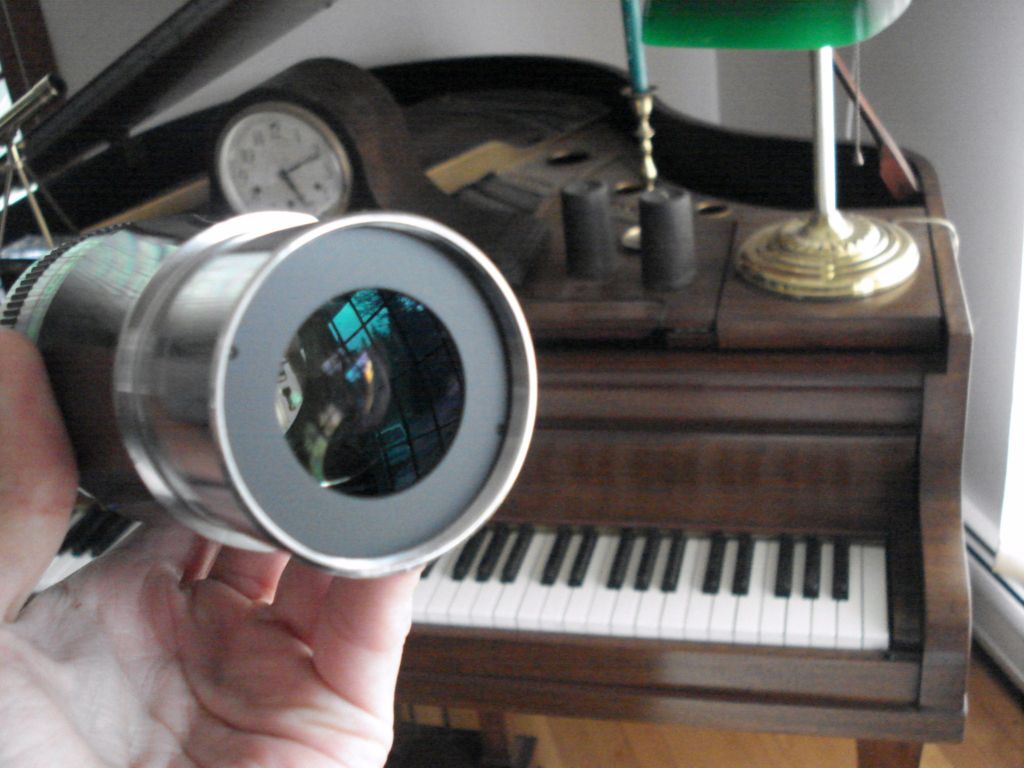
Bottom of the 17 mm Ethos - Again, be careful where you put your fingers!
The 8 mm is also a wonderful eyepiece. It was a luxury to have a planetary eyepiece that was so comfortable. It reminds me of the original 9 mm Type 1 Nagler, only with updated glass. As a (mild) bonus, it does cost slightly less than the others. So if you need to justify its purchase to your significant other, tell them I said it was OK.
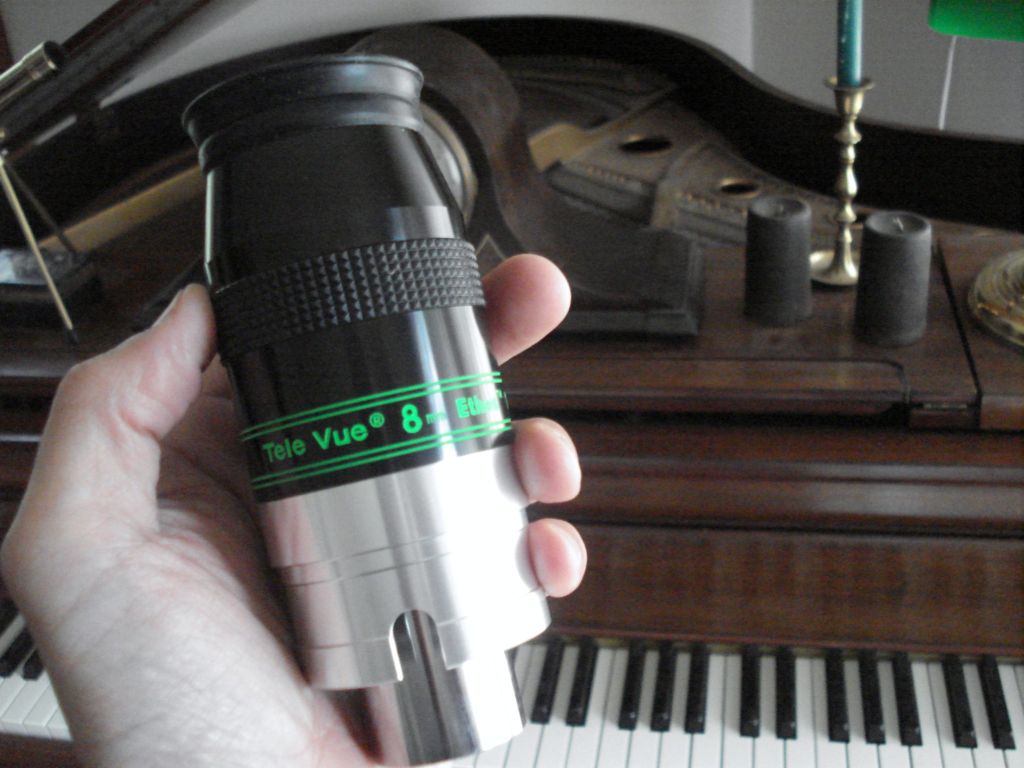
The 8 mm Ethos ($585)
The 8 mm Ethos threw up fantastic views of Jupiter in the Oak Classic. During times of steady seeing, the image was crisp and solid. I could have easily been fooled into thinking that this was a dedicated planetary eyepiece. I can picture the planetary/lunar/double star crowd going nuts over this eyepiece. Just be careful that it isn't too strong in your scope. If your telescope's focal length is over 1600 mm or so, check it out, preferably in your own equipment, before buying. It was way too strong in the 2500 mm focal length 20" Obsession, for example (we were looking for moons around Uranus by that time of the evening and the 13 mm was about as strong as we'd dare go.)
On the other hand, if you have a small refractor like a TeleVue 76 or an Orion ED80, you're going to be thrilled. My TeleVue Pronto loves this eyepiece. At 60X, the magnification is just enough to frame the showpiece objects like the Double Cluster, M31, and M11. It also did remarkably well on M81/M82, M15, M17, and M8. 60X is also just enough that you can start to make out some detail on Jupiter. One observer, watching me work through these objects under a dark sky with the Pronto, said "makes you wonder why we need all those big scopes, eh?"
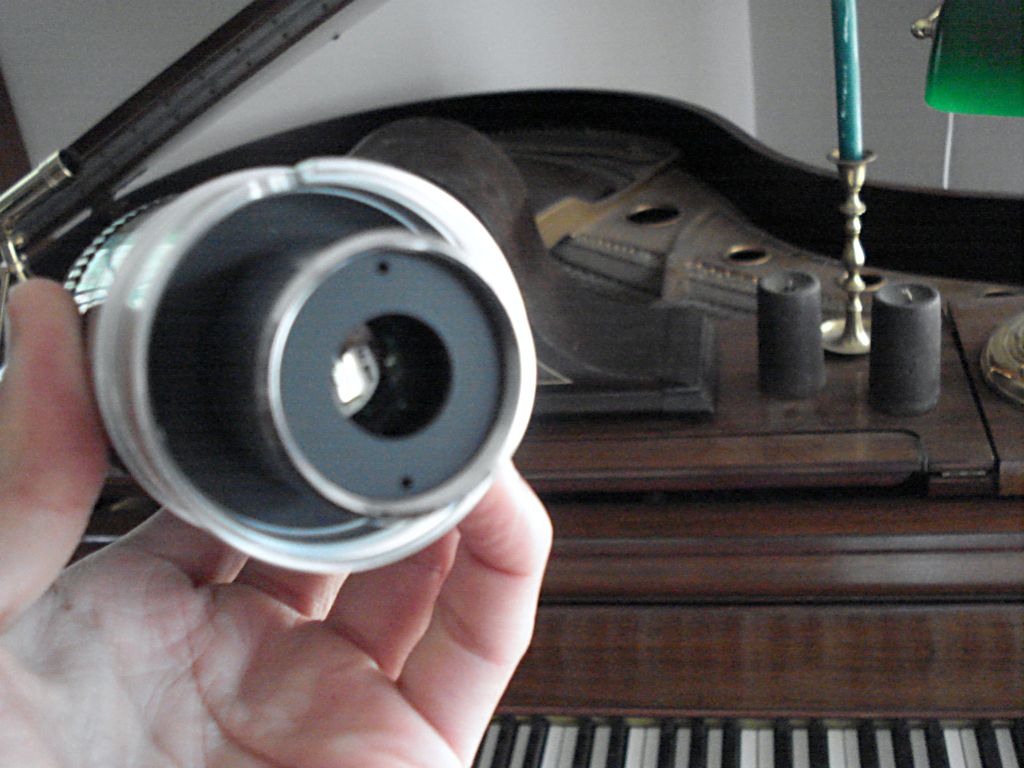
Bottom of the 8 mm Ethos
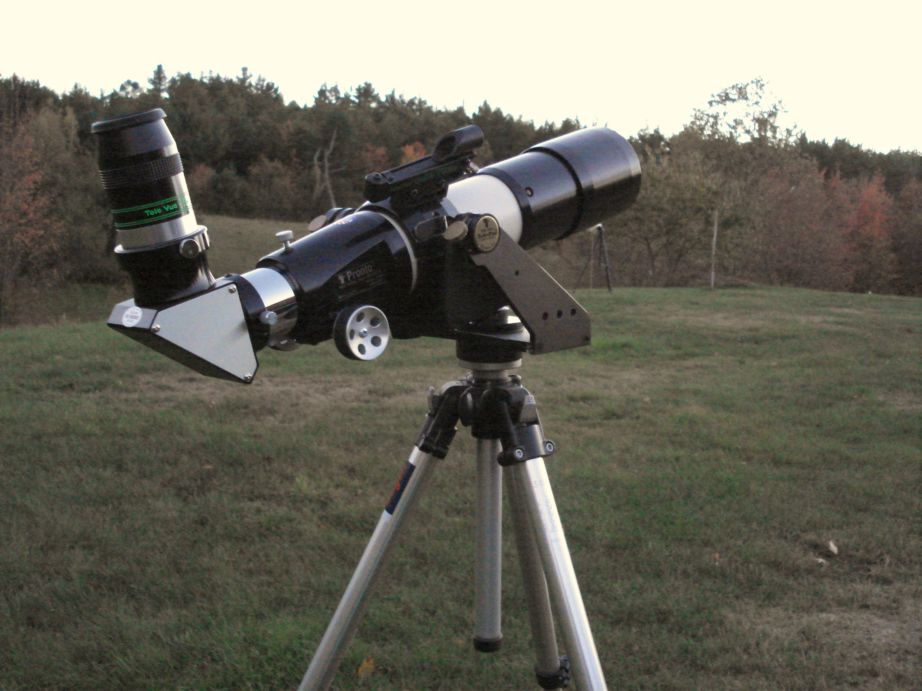
Made for each other: The 8 mm Ethos and the Pronto
Drawbacks? Everyone complained about the price. But in today's world, where $625 31 mm Naglers are fairly common, the extra money for these Ethos eyepieces doesn't seem like too much of a stretch. We've entered a brave new world where a 19 mm Panoptic is table stakes. It was nearly impossible to fault these Ethos eyepieces on performance grounds. Once, I allowed the full moon to drift out of the field of view on the 13 mm and noticed a tiny ring of color right at the field stop. But this is nitpicking in the extreme. It's like making fun of Cindy Crawford because she's got that mole.
Conclusions? Among the 13 mm eyepieces, most of us preferred the Ethos, but two of us thought the Type 6 Nagler was the best. At $245 less than the Ethos, it's a relative bargain. And what of the old Type 1 Nagler? It's still an impressive eyepiece, and worth owning. They show up from time to time on the used market at attractive prices. I've seen a few lately in the $150 - $175 range. If that's all you can afford, they're still highly recommended and worth picking up. For someone who grew up watching those old Nagler ads -the 13 mm retailed for $395 back then- it is a real temptation to get one. I have great love and nostalgia for these older TeleVue eyepieces (remember the craze over the Type 1 11 mm Nagler about 10 years ago?) but even I have to admit, the newer stuff is better. The 13 mm Type 6 outclasses its bigger older brother in every way save eye relief, and it's smaller and lighter.
I've gotten into some hot water before by declaring this-or-that TeleVue design is the Ultimate Eyepiece. Having learned my lesson, I'll stop just short of saying that here. But the Ethos is so good, it leaves me wondering - how is TeleVue going to top this??
Counterpoint: Notes From the Observing Field
Herb B:
If I needed the extra cash I would sell it and pick up the Type 1, even though I did notice the kidney bean effect with the Type 1. I did not notice it with the Ethos nor with the Type 6. I would get the Type 1 because the kidney bean effect doesn't bother me that much and I found both the Ethos and the Type 1 to be more comfortable to view through than the Type 6. I had to go back and forth between the Ethos and Type 6 several times and other than the larger field and the more comfortable feeling of the Ethos, there was very little difference between the two eyepieces. The Ethos for some reason seemed to make M13 slightly brighter but the background also seemed a little brighter than in the Type 6. I think the Type 6 may have slightly better contrast."
John B:
All these wide field eyepieces made my University Optics orthoscopics look like I was looking through a soda straw.
Gardner G:
"Indeed
that was a fun evening. Good to see everyone there.
I tried to find differences between the Ethos-T6-T1 by looking at the faintest stars in the field and seeing if there were there in all three. Stuff that was right on the limit of direct vision. In all three eyepieces I could see all the same faint stars around M13. I really like the Ethos view for the immersion factor but when compared side by side with the T6 I liked the Nagler design better. They T1 also had just a bit brighter sky than the T6, right about the same level of the Ethos. The contrast seemed just a bit better with the T6, the sky was slightly darker each time in the T6 on both scopes we tried them in. You’d probably never notice it unless you did a side-by-side like we did. They are all wonderful eyepieces and I’d be happy with any of them. I’ll hang onto my 13 T6 for now as I have plenty of friends with these Ethos in their eyepiece cases!"
Chase M:
"I agree with Herb and Gardner on the slight differences
between the 3 eyepieces. I liked the Ethos but I would never spend the
money. I was surprised and glad to see the T1 perform as well as it
did. Makes a great buy on the used market. I prefer the T6 with its
great optics and it lower price compared to the Ethos and its smaller size
compared to the other two.
Don't get me wrong, whenever I have a chance to look through somebody
else's Ethos I will be in line to take in the great view."